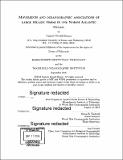| dc.contributor.advisor | Simon R. Thorrold. | en_US |
| dc.contributor.author | Braun, Camrin Donald | en_US |
| dc.contributor.other | Woods Hole Oceanographic Institution. | en_US |
| dc.coverage.spatial | ln----- | en_US |
| dc.date.accessioned | 2019-01-11T16:08:07Z | |
| dc.date.available | 2019-01-11T16:08:07Z | |
| dc.date.copyright | 2018 | en_US |
| dc.date.issued | 2018 | en_US |
| dc.identifier.uri | http://hdl.handle.net/1721.1/119992 | |
| dc.description | Thesis: Ph. D., Joint Program in Applied Ocean Science and Engineering (Massachusetts Institute of Technology, Department of Earth, Atmospheric, and Planetary Sciences; and the Woods Hole Oceanographic Institution), 2018. | en_US |
| dc.description | Cataloged from PDF version of thesis. | en_US |
| dc.description | Includes bibliographical references (pages 138-154). | en_US |
| dc.description.abstract | Highly migratory marine fishes support valuable commercial fisheries worldwide. Yet, many target species have proven difficult to study due to long-distance migrations and regular deep diving. Despite the dominance of oceanographic features, such as fronts and eddies, in the open ocean, the biophysical interactions occurring at the oceanic (sub)mesoscale (< 100 km) remain poorly understood. This leads to a paucity of knowledge on oceanographic associations of pelagic fishes and hinders management efforts. With ever-improving oceanographic datasets and modeling outputs, we can leverage these tools both to derive better estimates of animal movements and to quantify fish-environment interactions. In this thesis, I developed analytical tools to characterize the biophysical interactions influencing animal behavior and species' ecology in the open ocean. A novel, observation-based likelihood framework was combined with a Bayesian state-space model to improve geolocation estimates for archival-tagged fishes using oceanographic profile data. Using this approach, I constructed track estimates for a large basking shark tag dataset using a high-resolution oceanographic model and discovered a wide range of movement strategies. I also applied this modeling approach to track archival-tagged swordfish, which revealed affinity for thermal front and eddy habitats throughout the North Atlantic that was further corroborated by synthesizing these results with a fisheries-dependent conventional tag dataset. An additive modeling approach applied to longline catch-per-unit effort data further highlighted the biophysical interactions that characterize variability in swordfish catch. In the final chapter, I designed a synergistic analysis of high-resolution, 3D shark movements and satellite observations to quantify the influence of mesoscale oceanography on blue shark movements and behavior. This work demonstrated the importance of eddies in structuring the pelagic ocean by influencing the movements of an apex predator and governing the connectivity between deep scattering layer communities and deep-diving, epipelagic predators. Together, these studies demonstrate the breadth and depth of information that can be garnered through the integration of traditional animal tagging and oceanographic research with cutting-edge analytical approaches and high-resolution oceanographic model and remote sensing datasets, the product of which provides a transformative view of the biophysical interactions occurring in and governing the structure of the pelagic ocean. | en_US |
| dc.description.statementofresponsibility | by Camrin Donald Braun. | en_US |
| dc.format.extent | 154 pages | en_US |
| dc.language.iso | eng | en_US |
| dc.publisher | Massachusetts Institute of Technology | en_US |
| dc.rights | MIT theses are protected by copyright. They may be viewed, downloaded, or printed from this source but further reproduction or distribution in any format is prohibited without written permission. | en_US |
| dc.rights.uri | http://dspace.mit.edu/handle/1721.1/7582 | en_US |
| dc.subject | Joint Program in Applied Ocean Science and Engineering. | en_US |
| dc.subject | Earth, Atmospheric, and Planetary Sciences. | en_US |
| dc.subject | Woods Hole Oceanographic Institution. | en_US |
| dc.subject.lcsh | Fishes Migration | en_US |
| dc.subject.lcsh | Fisheries | en_US |
| dc.subject.lcsh | Pelagic fishes | en_US |
| dc.subject.lcsh | Animal behavior | en_US |
| dc.subject.lcsh | Eddies | en_US |
| dc.subject.lcsh | Animal marking | en_US |
| dc.title | Movements and oceanographic associations of large pelagic fishes in the North Atlantic Ocean | en_US |
| dc.type | Thesis | en_US |
| dc.description.degree | Ph. D. | en_US |
| dc.contributor.department | Joint Program in Applied Ocean Physics and Engineering | en_US |
| dc.contributor.department | Woods Hole Oceanographic Institution | en_US |
| dc.contributor.department | Massachusetts Institute of Technology. Department of Earth, Atmospheric, and Planetary Sciences | |
| dc.identifier.oclc | 1080939067 | en_US |
